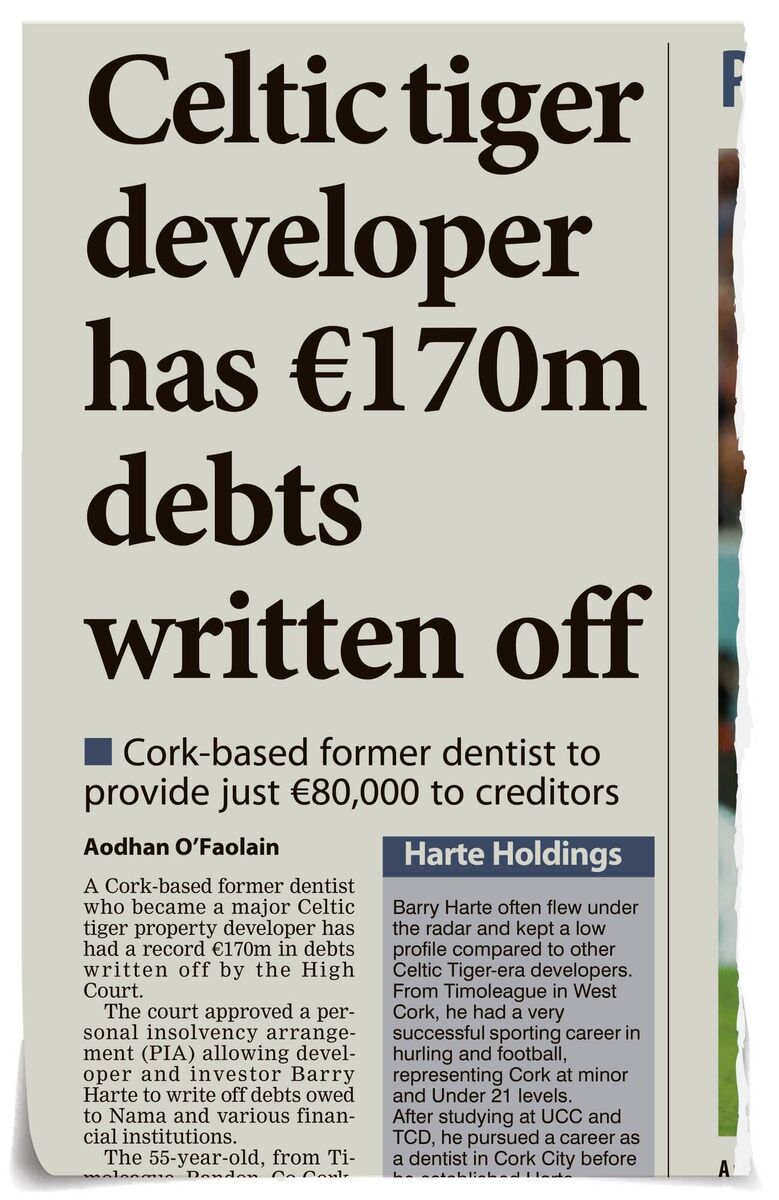Special report: High profile debt deals are the tip of the iceberg

Rory McIlroy shakes hands with Jonathan Sexton, alongside DJ Carey. Carey’s fondness for golfing trips in the US at the same time he was playing the poor mouth gave rise to one question: ‘why is it one rule for him and another for the rest of us?’ Picture: Ramsey Cardy/Sportsfile
When it emerged in February that Kilkenny hurling legend DJ Carey had seen the majority of close to €10m in loans written off in 2017, the general public reaction was one of collective outrage.
It subsequently emerged that Carey’s writedown was closer to 80% than the 99% originally reported, given a number of investment properties he had owned had been sold as part of the deal reached with lender AIB.
Nevertheless, the sheer scale of the let off — not helped by stories which emerged in the aftermath regarding Carey’s fondness for golfing trips in the US at the same time he was playing the poor mouth regarding his own creditors back home — gave rise to one question: ‘why is it one rule for him and another for the rest of us?’
The truth, as so often in life, is a bit more complicated, however the fact remains that banks are far keener to get rid of problem debt like Carey’s than they are to allow your average mortgage borrower who has missed three or four payments to do the same.
Multimillion write-down stories are common ones in the Irish courts. Last month for example, the High Court approved a €4.4m write-off for former Waterford Fianna Fáil councillor Thomas Mulligan, who per the settlement would be contributing just €9,000 to his creditors.
However, what was happening in that case, indeed what is happening in all such stories involving approved write-offs, is the courts were ruling on Mulligan’s personal insolvency process.
In his case, by the time Justice Alexander Owens had approved the enormous write-off, there was no opposition from creditors, who had been informed that the return they would get under the PIA would exceed anything they were likely get from his potential bankruptcy.

So what is personal insolvency, why do people need it, and why are the banks so willing to engage with it?
Ireland's Personal Insolvency Act became law in late 2012 and was a direct result of the fallout from the 2008 financial crash, which saw the country’s property market torpedoed into oblivion. That created an ocean of borrowers, large and small, who were suddenly unable to match their debts.
“We were late to the party in terms of countries focusing on issue of problem debt,” says financial planner Eoin McGee.
“You had the case where it just wasn’t fair, people had made the same mistake, but they shouldn’t have had to live with it forever,” he says.
Bringing in the PI process led to a flurry of activity at the beginning as those whose Celtic Tiger fortunes had nosedived at the time of the crash moved to clear themselves of their debt with a view to starting again.
When does someone get into the process?
“It’s as soon as the maths don’t work out,” Mr McGee says.
“Don’t assume that it’s an easier ride if you’re famous. The bank will have to be absolutely satisfied beyond doubt that they’re not getting their money back, it doesn’t matter who you are. If they’ve come to that conclusion then they’ll make a commercial decision,” he says.
There are different layers to the insolvency process, from small to large scale.
As someone who was raised to be endlessly fearful of debt, the ease with which people can get themselves into trouble is eye-opening.
“For people in their late 20s, ignoring people with savings, to have reached that age with zero debt is not common. Between 60% and 80% of them will have some sort of debt, because the loans are being thrown at them,” says McGee.
“Then there are credit cards. I’d estimate the proportion of people who never pay interest on a credit card is about 5%. That’s the spiral you can get caught out on.”

The less complicated kinds of debt resolution mechanisms are debt relief notices (DRN — for unsecured, that is without security or collateral, debts up to €35,000) and debt settlement arrangements (DSA — for unsecured debt only with no monetary limit).
There have been more than 2,000 DRNs approved to date, and roughly 1,500 DSAs. But the most high profile and prominent debt mechanism is the personal insolvency arrangement (PIA), given it deals with both secured debt (a mortgage or mortgages typically) and the unsecured variety.
Last year there were more than 800 PIAs approved dealing with a total of €632m worth of debt (one of them worth a whopping €171m — the majority of it unsecured debt).
Someone looking to get into the process generally starts with an intermediary service, the most prominent in Ireland being the not-for-profit Money and Budgeting Service (MABS). From there, the next stop is Personal Insolvency Practitioner (PIP), a prerequisite for a PIA, who henceforth deals with the applicant’s creditors.
Sean McMahon is a sole-operator PIP, which makes him smaller-scale in the grand scheme of things, operating out of Ballinteer in south Dublin.
While some of his clients come from MABS, a lot also come from his contacts in the legal profession and financial services built up over 30 years working as a lender. He got into the PIP side of things in 2018.
“I’d had enough of chasing people for money, I’d much rather be on the other side doing what I’m doing now,” he says.
“It’s good in this job to be non-judgemental,” Mr McMahon says. “You meet people and they think there’s absolutely nothing that can be done for them.”
He cites one older couple who came to him with a significant amount remaining on their mortgage and a lender chomping at the bit. “They thought the bank had the absolute power to take stuff off them. But they don’t.”
When people agree a debt arrangement with the PIP, it will be based upon their net income less their reasonable living expenses (RLE) — what they are allowed spend on basic living overheads and on non-essential expenses.
Everything else should be used on servicing their debt, with creditors and the PIP agreeing what a final total due should be. Living under such constraints is not an easy expectation.
For Mr McMahon however, therein lies the benefit for those who enter into a debt arrangement.
Regardless, he says, while you’re unlikely to lose your home (taking the family home is a rare action on the part of Ireland's pillar banks — it's not a good look), PIAs are nevertheless no get-out-of-jail-free card.
“There is always financial pain,” he says, citing the example of the €2.9m debt writeoff arrangement entered into by musician Frank McNamara, husband of barrister and former RTÉ presenter Theresa Lowe, in 2020.
"He got to keep the family home," Mr McMahon says, noting he will be repaying the debt for decades to come, and had to give up his pension.

“In the case of Carey, he had to hand back all his properties and €60,000. The creditors did far better out of it than if he’d gone bankrupt.”
“The personal insolvency process was set up for those who couldn’t pay. If you look at the US, bankruptcy isn’t looked down upon there with scorn as it is here. They’re a country of risk takers. Whereas prior to 2013 if you took a risk and went bankrupt in Ireland you were banjoed for 12 years,” he says.
By contrast, PIAs can last anything from a month up to six years.
While the average PIA approved in 2022 was for €571,000, it is the larger ones that inevitably garner the most headlines.
These huge multimillion debts are in most cases hangovers from the financial crash.
“There was a time for about five months ten years ago when one bank was withdrawing from the market, and they were told to write down everything they could, they just wanted out,” says Eoin McGee.
“We had one client with a €1.6m mortgage and they were told give us €700,000 and we’ll get rid of it, but they couldn’t come up with the price.”
More recently, the banks’ willingness to settle massive debts doesn’t come down to altruism — from 2017 onwards pillar lenders came under massive pressure from the European Central Bank (ECB) to get their legacy levels of non-performing loans (NPLs) under a certain threshold (roughly 5%). Such loans are a constant burden on a lender’s ability to do future business.
“The reality is, if you owe them €100,000 then you’re in trouble, if you owe them €100m then they’re in trouble,” says Mr McGee.
For that reason Ireland’s various banks began selling enormous tranches of NPLs to reduce their ratio of bad debts — primarily to institutional lenders — the infamous vulture funds, for whom normal lending practices such as client engagement do not apply.
That has led to a number of new trends in the personal insolvency sphere.
“The DJ Carey stuff has caused a bit of a rumpus,” says Anthony Joyce, principal with Anthony Joyce and Co Solicitors which specialise in personal insolvency.
Mr Joyce says that as a representative for debtors, “while we think there could be improvements, broadly speaking the system is working”.
“Carey is the kind of one you hear about, but in the courts every day there are lots of people getting write-downs or extensions in a structured way. There’s pretty much a solution for everyone,” he says.
Mr Joyce does have a number of “bugbears” however. One is the sheer aggression of the vulture funds, who push for repossession at a rate unheard of for regular lenders. Another is vultures attempting to get payment for mortgage debt more than 12 years old, which is over its statute of limitations. But most of the troubled borrowers don’t know that.
The last is niche, but worrying: “The vultures and banks are still reporting that the debt is owing even though somebody went through a bankruptcy or arrangement. We write to the creditor and request a change but they don't change it. Then we then have to sue for defamation! It is just more hassle for the debtor who wants to get on with their life,” Mr Joyce says.
Personal insolvency in Ireland has predominantly dealt with the legacy of the Celtic Tiger, and dealt with it well. But we’re entering a new era, and that may bring new trends.

After 10 years of historic low interest rates, inflation has led to a massive series of rate hikes by the European Central Bank in recent months. That, and the cost of living crisis means that some people’s mortgage payments may have jumped by a factor of thousands. Per month.
“Interest rates were so low on problem mortgages which were interest-only, for maybe ten years, that people didn’t deal with it,” says Mr Joyce.
“Now the ECB has gone from 0% to 3.5%, and someone with three properties from pre-crash might have seen their payments go from €2,000 to €7,500 per month.”
Mr McMahon notes that recently he has been getting inquiries from “people I would not normally have heard from — well-paid professionals whose businesses are being hit by rate increases and who are very concerned about future repayments if the trend continues.”.
“There may be people availing of the personal insolvency process over the coming year who previously would never have even considered it as an option."











